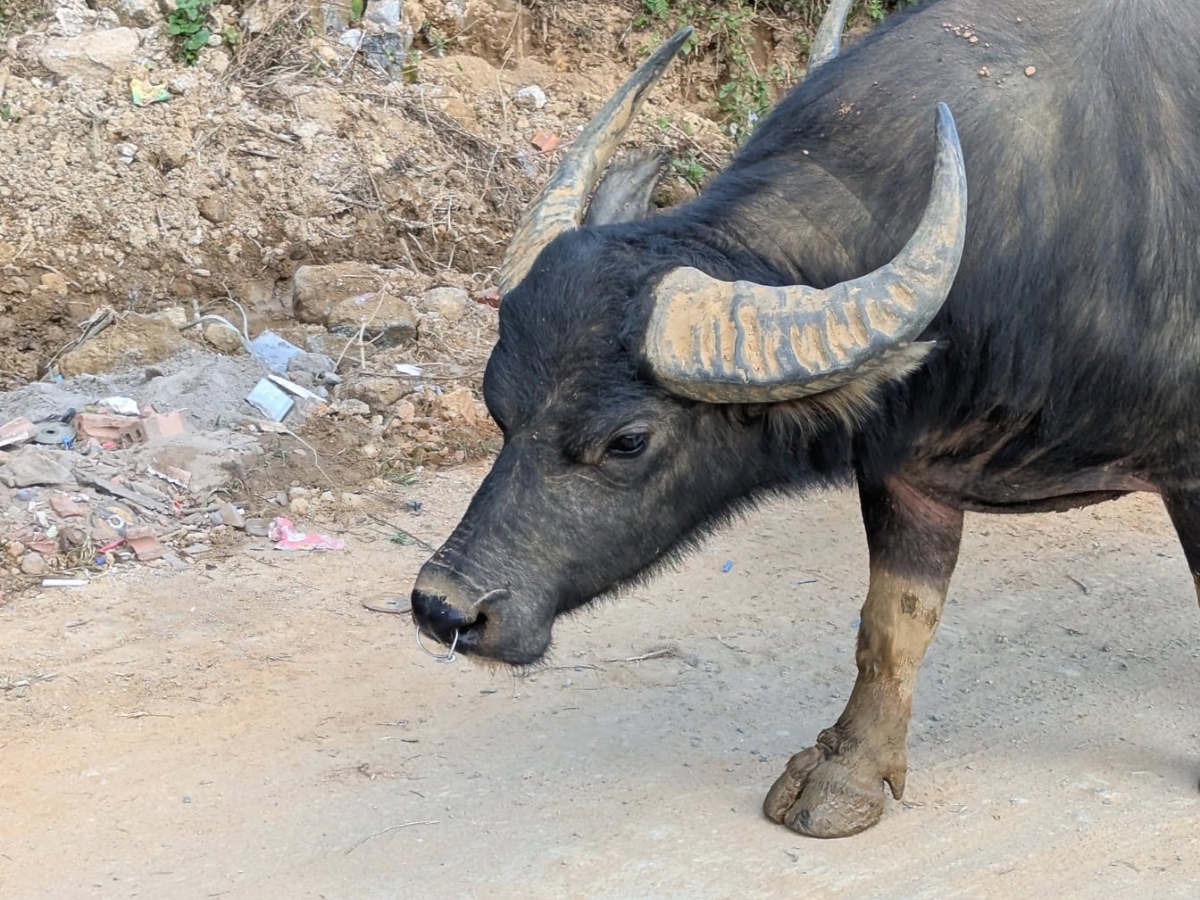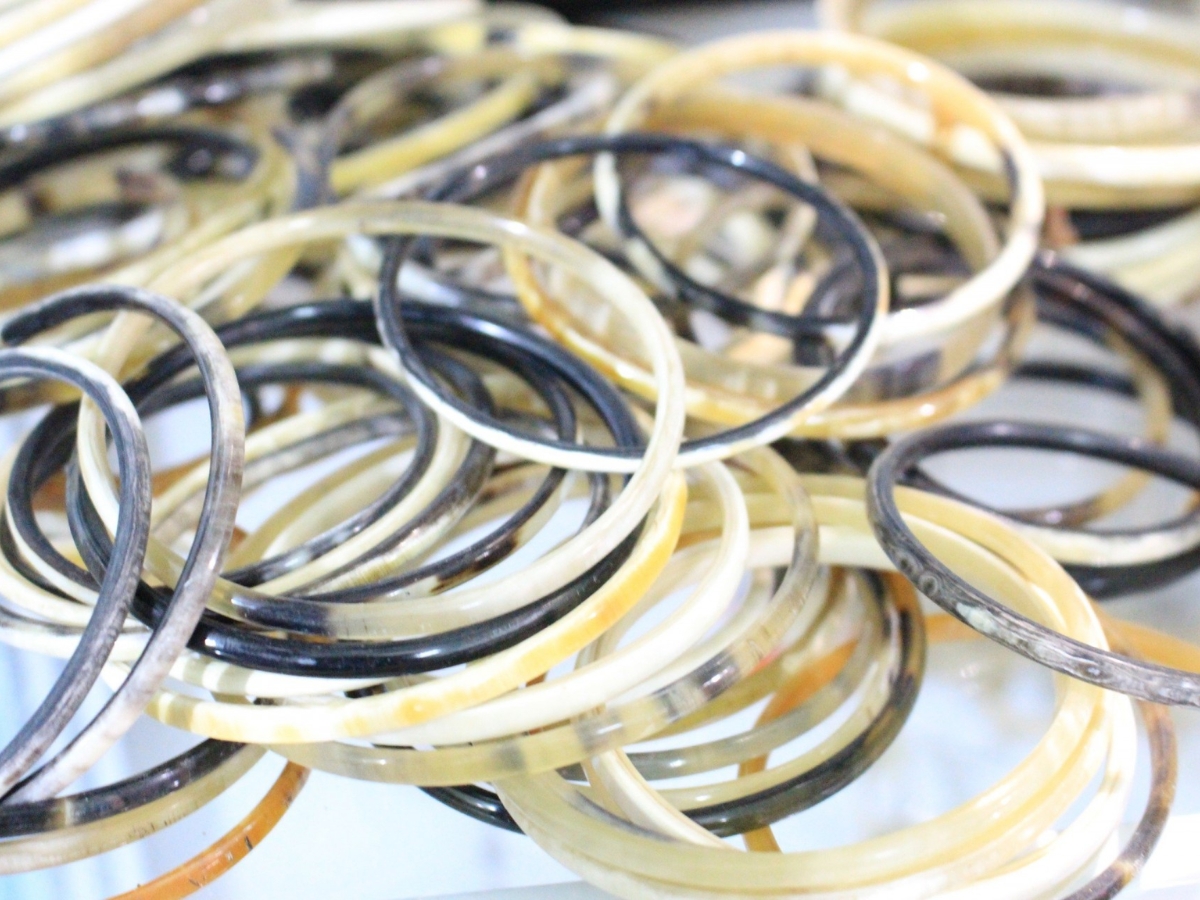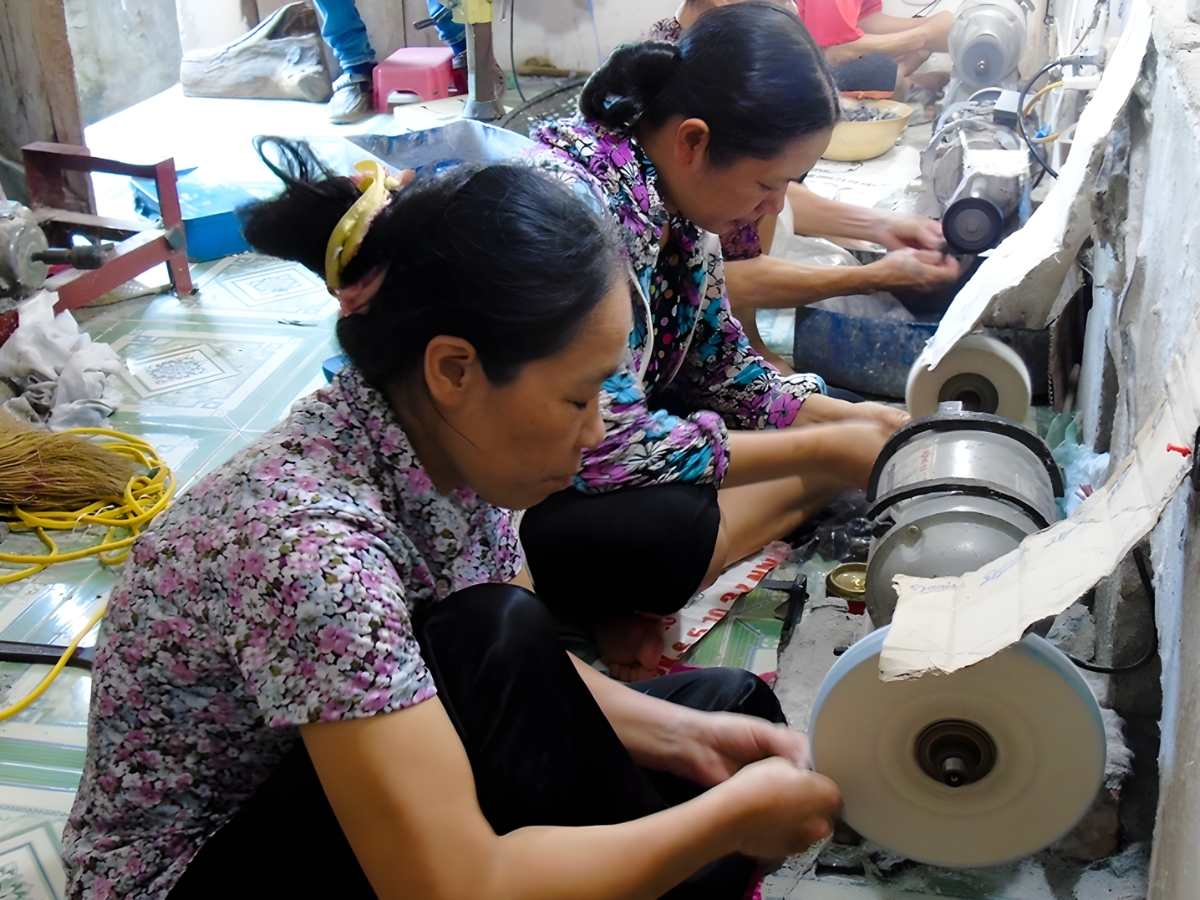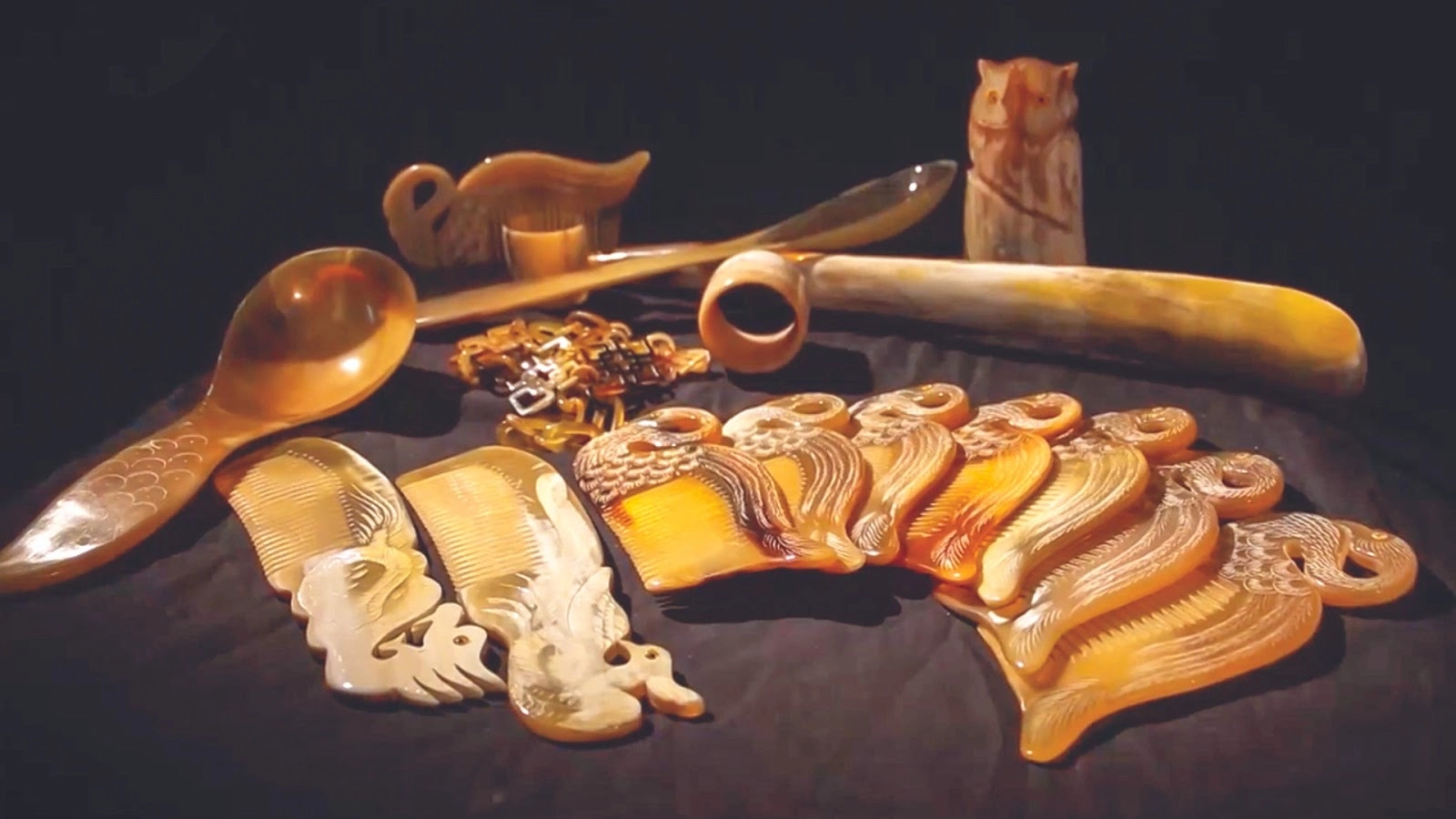1. Discover the Do Hai horn fine art craft village
1.1. Where is the Do Hai horn fine art craft village?
Nestled along peaceful village roads, the Do Hai horn fine art craft village is located in Binh Son commune, Ninh Binh province, a destination that evokes the traditional beauty of Vietnamese craft villages. From Hanoi, visitors only need to travel about 80 km south along National Highway 1A or the Phap Van – Cau Gie – Ninh Binh expressway. Upon reaching Phu Ly, turn an additional 20 km southeast, and you will see rooftops peeking through green trees, where artisans diligently imbue each exquisite horn product with soul.

Visit Do Hai fine art horn village in Binh Son commune, Ninh Binh province. (Source: hanamtourism.vn)
The distance from Phu Ly center to the craft village takes only about 30 minutes by car or motorbike, very convenient for a short trip. The road leading into the village is shaded by trees, interspersed with the familiar sounds of chiseling and grinding from small workshops. All signal the journey to discover a centuries-old famous craft village awaiting ahead.
1.2. History of the formation of Do Hai craft village
Do Hai fine art horn village has a history of over a century, beginning to form in the late 19th century with the contribution of Master Nguyen Van Tan, who is considered the ancestor of the horn craft in the region. In the early days, simple products such as horse whips, hat straps, brushes, grape seeds... were created mainly to serve the daily needs of the people of Bac Bo. Although rustic, each item contains the skill and sophistication of the artisan's hands, laying the foundation for the village's reputation later on.
Entering 1957, the craft village marked an important milestone with the establishment of the Thanh Son Handicraft Cooperative, gathering 70 households to produce and expand product lines together. This is considered the first golden period, when the village's products began to diversify and gain a firm foothold in the domestic market.
The products of Do Hai horn village are increasingly diverse, not only meeting the demands of the domestic market but also exported to countries such as the Soviet Union, Eastern Europe, China, Cuba, and are widely welcomed. With continuous perseverance and creativity, by 2004, the former Ha Nam Provincial People's Committee officially recognized Do Hai as a traditional craft village, affirming its position as a symbol of exquisite craftsmanship in the heart of the Bac Bo delta.
1.3. Cultural values of Do Hai craft village
Do Hai fine art horn village is a vivid symbol of the cultural identity of the craft villages in the Bac Bo delta region, where human dexterity and creativity blend with long-standing traditions. The horn craft here is not just a livelihood, but has become an integral part of community cultural life, associated with every household and every old village story.
The deepest cultural value of Do Hai lies in the diligent, meticulous, and creative spirit of craftsmanship, passed down through generations. Each product created by the artisans here carries exquisite techniques and the dedication of the craftsmen, conveying pride and reverence for the craft ancestors. The smooth curves and natural luster of the horn after processing not only demonstrate master craftsmanship but also testify to the perseverance and love for the profession of the Do Hai people.
For them, handicraft is not just a job but also a bond that connects the community, a cultural source that helps people connect, share, and preserve precious traditional values. Thanks to this, Do Hai is known not only as a century-old craft village but also as a living museum preserving the essence of craftsmanship and the soul of the Bac Bo land.
2. Production process of Do Hai fine art horn
2.1. Raw materials: buffalo horn, cow horn
The exquisite quality of Do Hai fine art products originates from the very selection of raw materials. Buffalo horns and cow horns are collected from the plains and midland regions of Bac Bo, where raw materials are abundant and stable, ensuring a sustainable supply chain for the craft village for decades.

Handicraft products made from natural buffalo horn and cow horn. (Source: Collected)
Do Hai artisans are particularly meticulous in selecting horn: only strong, non-pitted, thick-fibered, smooth, and evenly colored horns are used. After being cleaned, soaked, and dried using traditional methods, the horn retains its natural flexibility and high durability, while preserving its characteristic iridescent original color. It is this meticulousness from the very first steps that has created the foundation of quality and reputation for the Do Hai horn handicraft brand, making products from here always stand out in the domestic and international handicraft market.
2.2. Main stages in horn crafting
To create a complete horn handicraft product, Do Hai artisans must go through many meticulous and elaborate stages, requiring precision and patience at each step. First, the horn material is roughly cut according to the size and shape suitable for the product to be crafted. Then, the horn is softened by heating or baking, and then manually shaped according to the design. This is a stage that requires the artisan's skill and delicate touch to avoid cracking, while preserving the horn's flexibility and natural color.
Next is the sanding stage, which makes the product surface smooth, fine, and harmonious in every detail. Once the standard shape is achieved, artisans proceed to carve traditional patterns using specialized tools, demonstrating their aesthetic level and skillful craftsmanship. Each carved line and etched stroke carries the breath of folk culture and the unique style of the craft village.
The final stage is natural polishing, which makes Do Hai products always stand out with their smooth gloss and beautiful durability. Instead of using chemicals, artisans remain loyal to dried banana leaves or beeswax, which are both safe and preserve the characteristic iridescence of the horn. Thanks to this standardized process, each finished product is a combination of technique, art, and the artisan's soul.
2.3. The role of Do Hai artisans in each product
What creates the unique identity of the Do Hai horn handicraft village is its team of talented artisans. In Do Hai, the craft does not distinguish by gender, as both men and women participate in the most intricate stages, contributing to maintaining the reputation of this hundred-year-old craft village.
Stages requiring high technical skill and extensive experience are usually assigned to veteran artisans, while younger individuals are guided through more basic steps to hone their skills. The process of passing down the craft primarily occurs within families, where techniques, secrets, and the spirit of the craft are passed down through generations.
This 'father-to-son' inheritance model has helped the Do Hai horn craft retain its traditional essence, while continuously evolving with the times. Each product created is not only a crystallization of skillful craftsmanship, but also an extension of pride and the cultural heritage of Vietnamese craft villages.
3. Prominent product lines at Do Hai horn handicraft village
3.1. Daily use items: combs, hairpins, pens, cups
Everyday items such as Do Hai horn combs are highly valued for their softness, anti-static properties, and ability to make hair naturally shiny and healthy. Additionally, items like hairpins, bracelets, and drinking cups feature beautiful designs, diverse styles, retaining natural horn patterns and textures that are rarely seen.

Types of bracelets made from the skillful hands of artisans from the Do Hai horn handicraft village. (Source: Collected)
When it comes to handicraft items, products from the Do Hai horn handicraft village are always highly appreciated thanks to traditional firing and pressing methods and manual polishing techniques that retain natural colors, creating superior durability. These items are not only useful for daily life but also suitable as gifts thanks to their special beauty and meaning.
3.2. Artworks: dragon statues, 12 zodiac sets, art paintings
Besides everyday items, Do Hai artisans also apply their skillful craftsmanship to create many works such as dragon and phoenix statues, the 12 zodiac animal sets, the Three Star Gods statues, along with folk art paintings. Each work reflects aesthetic level and profound knowledge of traditional culture, creating a sense of closeness to Vietnamese life.
These works are loved for their artistic value and also carry feng shui meanings, conveying wishes for peace and good happiness. Many families also choose to display products from the Do Hai horn handicraft village in their living spaces or workplaces as a way to show appreciation for enduring cultural values.
3.3. Export products and international quality
Not many domestic craft villages achieve export capabilities like the Do Hai horn handicraft village. Products from here have been selected for export to the Soviet Union, Eastern Europe, China, Cuba thanks to strictly meeting standards for appearance, health safety, and aesthetics.
The pre-export inspection process is conducted strictly: from toxicity testing, to requiring a safe polishing layer for users, while ensuring natural origin criteria and the non-use of harmful chemicals. Artisans must also meet ecological inspection certifications, contributing to maintaining the reputation of the Do Hai horn handicraft village brand in the international market.
4. Tourism Experience at Do Hai Horn Handicraft Village in 2025
4.1. Directions to Do Hai Village
From Hanoi, visitors can easily reach the Do Hai horn handicraft village in just about 1.5 – 2 hours of travel. The journey is quite convenient with many transportation options such as private cars, motorbikes, or buses. The most popular route is National Highway 1A towards Phu Ly, then continue following the signs to Binh Son commune – where the Do Hai craft village is located. The road is flat, easy to travel, and has many tree-lined sections, making it very suitable for a short experience trip.
For visitors starting from southern provinces, you can take National Highway 10 to the area of Binh Son commune, then ask for directions or check a map to Do Hai village. Thanks to synchronized investment in transportation infrastructure, traveling to the craft village has become more convenient than ever. Whether choosing inter-provincial buses, taxis, or private vehicles, you can easily access the craft village without encountering road obstacles.
4.2. Sightseeing and interacting with artisans
When visiting the Do Hai horn handicraft village, visitors can witness firsthand the manual crafting process, from horn selection, shaping, to the final finishing stage. Those who love exploring traditional crafts can participate in experience workshops, performing a small step themselves under the meticulous guidance of local artisans.

Observe the horn handicraft production process of artisan Do Hai. (Source: Dan Tri Newspaper)
In the ancient village space, shops display thousands of products, from everyday items to exquisite sculptures. Visitors also have the opportunity to visit galleries of long-standing collectibles, listen to inspiring stories of the craft village tied to the imprints of each artisan family, creating a sense of closeness and authenticity.
4.3. Shopping for horn handicraft products as gifts
The Do Hai horn handicraft village offers a diverse selection of gifts such as horn combs, hairpins, bracelets, hair clips, cup and saucer sets, or mini 12 zodiac animal statues. Art enthusiasts can choose to buy small art paintings or exquisite decorative statues as souvenirs.
To choose a good product, you should prioritize items with even brightness, beautiful natural grain, and a smooth polished finish. Tourists should discuss the production process and care instructions with artisans to ensure the items retain their beauty long-term. Product prices are clearly listed, and customers can politely negotiate for a suitable price.
5. Experience and notes when traveling to Do Hai horn handicraft village 2025
The Do Hai horn handicraft village becomes most bustling and vibrant around the Lunar New Year, when an urgent work atmosphere spreads throughout the village alleys. This is when artisans are busy completing new products, while tourists and merchant groups flock to place orders and choose gifts.
Outside of the Tết season, the period from September to November is also considered ideal for visiting, when the autumn weather is cool and the gentle sun is very conducive to exploring the craft village space and immersing oneself in the unique traditional festivals of the Ha Nam region. Spring brings a different beauty, with the countryside adorned in fresh green, and artisans eagerly starting the first orders of the year, carrying an enthusiastic spirit of new beginnings.
To make your visit to the Do Hai horn handicraft village complete, visitors should note to maintain a polite attitude and respect the artisans' workspace. Before taking photos or trying to participate in any workshop stages, ask for permission from the host to avoid disrupting the production process. When purchasing goods, negotiate gently and friendly to preserve the open atmosphere, which is a characteristic beauty of traditional craft villages.
When selecting products, prioritize reputable points of sale, such as artisan shops recommended by locals. For high-value items, do not hesitate to ask clearly about the production process, care instructions, and origin certificates if needed, to ensure quality and purchasing rights. This respect and thorough understanding is also a way for tourists to contribute to maintaining the reputation of the Do Hai craft village.
If you have more time, you can combine a trip to Do Hai with nearby destinations in Ha Nam to enrich your journey. A suggested itinerary is to visit the craft village in the morning, learn about the production process, and choose souvenirs. In the afternoon, visit Sun World Ha Nam for entertainment or Tam Chuc Pagoda, a famous Buddhist complex with magnificent architecture and picturesque natural scenery.

Combine sightseeing and visiting Tam Chuc Pagoda. (Source: VnExpress)
Additionally, visitors can also visit historical sites in Binh Luc, Thanh Liem, or explore other traditional craft villages in the region to better feel the cultural beauty and the working spirit of the people of Ha Nam.
Do Hai Horn Handicraft Village is a place that preserves the cultural essence and unique handicraft art of Vietnam. A visit to Do Hai in 2025 will offer visitors the opportunity to admire the skillful craftsmanship of the artisans, while contributing to spreading and preserving the heritage value of the craft village through each product brought home.








